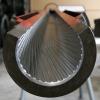morphology laboratory
A laboratory room dedicated to the examination of morphology, which is a branch in biology and medicine that studies the form and structure of organisms. In medicine, morphology applies in particular to the study of internal body organs, focusing on their shape, size, and structure, rather than their function.









